instrument panel FIAT FIORINO 2010 Owner handbook (in English)
[x] Cancel search | Manufacturer: FIAT, Model Year: 2010, Model line: FIORINO, Model: FIAT FIORINO 2010Pages: 210, PDF Size: 4.9 MB
Page 74 of 210
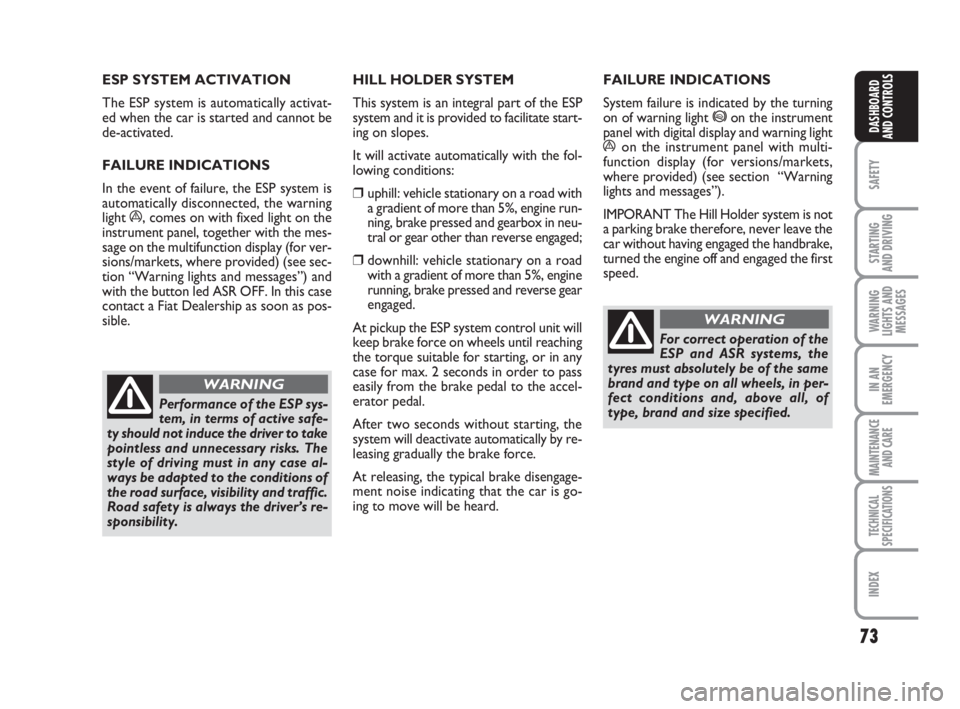
73
SAFETY
STARTING
AND DRIVING
WARNING
LIGHTS AND
MESSAGES
IN AN
EMERGENCY
MAINTENANCE
AND CARE
TECHNICAL
SPECIFICATIONS
INDEX
DASHBOARD
AND CONTROLS
ESP SYSTEM ACTIVATION
The ESP system is automatically activat-
ed when the car is started and cannot be
de-activated.
FAILURE INDICATIONS
In the event of failure, the ESP system is
automatically disconnected, the warning
light
á, comes on with fixed light on the
instrument panel, together with the mes-
sage on the multifunction display (for ver-
sions/markets, where provided) (see sec-
tion “Warning lights and messages”) and
with the button led ASR OFF. In this case
contact a Fiat Dealership as soon as pos-
sible.
Performance of the ESP sys-
tem, in terms of active safe-
ty should not induce the driver to take
pointless and unnecessary risks. The
style of driving must in any case al-
ways be adapted to the conditions of
the road surface, visibility and traffic.
Road safety is always the driver’s re-
sponsibility.
WARNING
HILL HOLDER SYSTEM
This system is an integral part of the ESP
system and it is provided to facilitate start-
ing on slopes.
It will activate automatically with the fol-
lowing conditions:
❒uphill: vehicle stationary on a road with
a gradient of more than 5%, engine run-
ning, brake pressed and gearbox in neu-
tral or gear other than reverse engaged;
❒downhill: vehicle stationary on a road
with a gradient of more than 5%, engine
running, brake pressed and reverse gear
engaged.
At pickup the ESP system control unit will
keep brake force on wheels until reaching
the torque suitable for starting, or in any
case for max. 2 seconds in order to pass
easily from the brake pedal to the accel-
erator pedal.
After two seconds without starting, the
system will deactivate automatically by re-
leasing gradually the brake force.
At releasing, the typical brake disengage-
ment noise indicating that the car is go-
ing to move will be heard.FAILURE INDICATIONS
System failure is indicated by the turning
on of warning light *on the instrument
panel with digital display and warning light
áon the instrument panel with multi-
function display (for versions/markets,
where provided) (see section “Warning
lights and messages”).
IMPORANT The Hill Holder system is not
a parking brake therefore, never leave the
car without having engaged the handbrake,
turned the engine off and engaged the first
speed.
For correct operation of the
ESP and ASR systems, the
tyres must absolutely be of the same
brand and type on all wheels, in per-
fect conditions and, above all, of
type, brand and size specified.
WARNING
036-082 Fiorino GB 1ed:036-082 Fiorino GB 1ed 30-11-2009 15:47 Pagina 73
Page 76 of 210
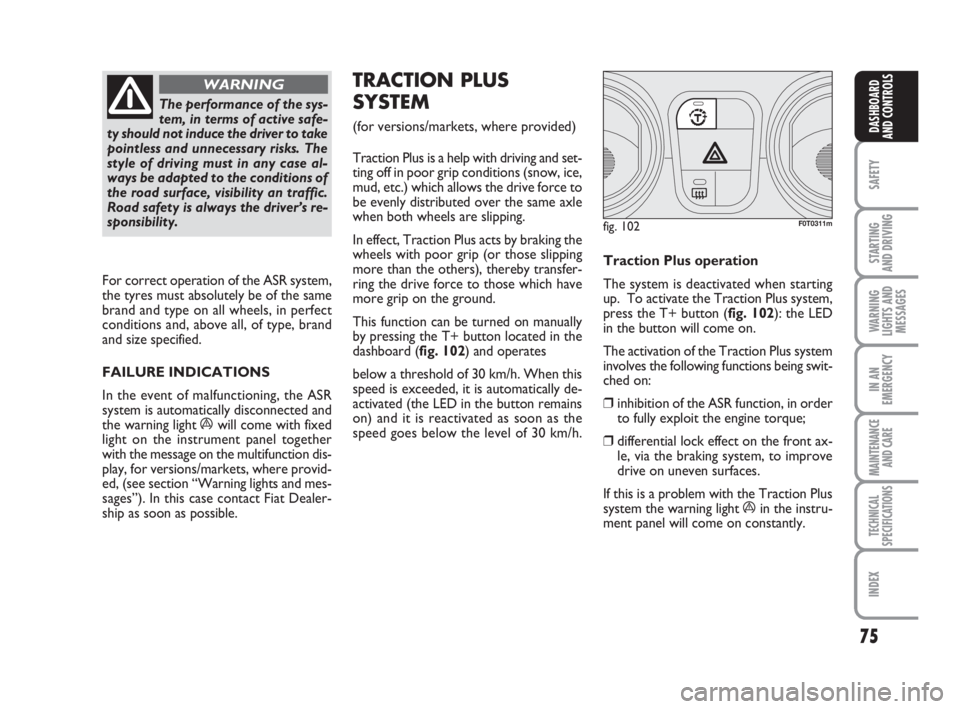
75
SAFETY
STARTING
AND DRIVING
WARNING
LIGHTS AND
MESSAGES
IN AN
EMERGENCY
MAINTENANCE
AND CARE
TECHNICAL
SPECIFICATIONS
INDEX
DASHBOARD
AND CONTROLS
The performance of the sys-
tem, in terms of active safe-
ty should not induce the driver to take
pointless and unnecessary risks. The
style of driving must in any case al-
ways be adapted to the conditions of
the road surface, visibility an traffic.
Road safety is always the driver’s re-
sponsibility.
WARNING
For correct operation of the ASR system,
the tyres must absolutely be of the same
brand and type on all wheels, in perfect
conditions and, above all, of type, brand
and size specified.
FAILURE INDICATIONS
In the event of malfunctioning, the ASR
system is automatically disconnected and
the warning light
áwill come with fixed
light on the instrument panel together
with the message on the multifunction dis-
play, for versions/markets, where provid-
ed, (see section “Warning lights and mes-
sages”). In this case contact Fiat Dealer-
ship as soon as possible.
TRACTION PLUS
SYSTEM
(for versions/markets, where provided)
Traction Plus is a help with driving and set-
ting off in poor grip conditions (snow, ice,
mud, etc.) which allows the drive force to
be evenly distributed over the same axle
when both wheels are slipping.
In effect, Traction Plus acts by braking the
wheels with poor grip (or those slipping
more than the others), thereby transfer-
ring the drive force to those which have
more grip on the ground.
This function can be turned on manually
by pressing the T+ button located in the
dashboard (fig. 102) and operates
below a threshold of 30 km/h. When this
speed is exceeded, it is automatically de-
activated (the LED in the button remains
on) and it is reactivated as soon as the
speed goes below the level of 30 km/h.Traction Plus operation
The system is deactivated when starting
up. To activate the Traction Plus system,
press the T+ button (fig. 102): the LED
in the button will come on.
The activation of the Traction Plus system
involves the following functions being swit-
ched on:
❒inhibition of the ASR function, in order
to fully exploit the engine torque;
❒differential lock effect on the front ax-
le, via the braking system, to improve
drive on uneven surfaces.
If this is a problem with the Traction Plus
system the warning light
áin the instru-
ment panel will come on constantly.
fig. 102F0T0311m
036-082 Fiorino GB 1ed:036-082 Fiorino GB 1ed 30-11-2009 15:47 Pagina 75
Page 94 of 210
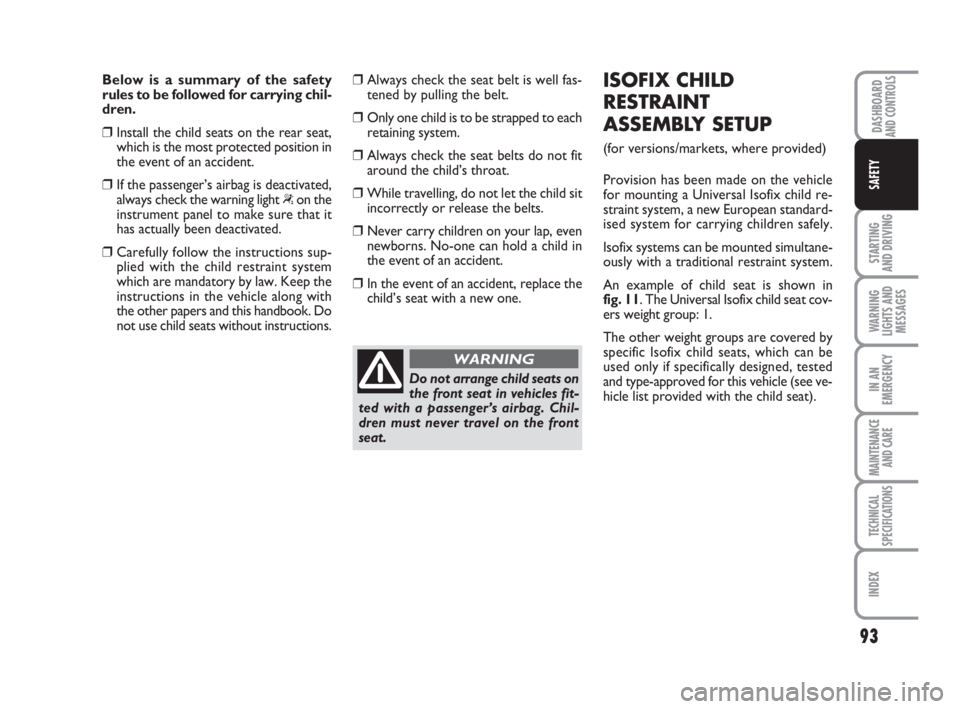
93
STARTING
AND DRIVING
WARNING
LIGHTS AND
MESSAGES
IN AN
EMERGENCY
MAINTENANCE
AND CARE
TECHNICAL
SPECIFICATIONS
INDEX
DASHBOARDAND CONTROLS
SAFETY
Below is a summary of the safety
rules to be followed for carrying chil-
dren.
❒Install the child seats on the rear seat,
which is the most protected position in
the event of an accident.
❒If the passenger’s airbag is deactivated,
always check the warning light
“on the
instrument panel to make sure that it
has actually been deactivated.
❒Carefully follow the instructions sup-
plied with the child restraint system
which are mandatory by law. Keep the
instructions in the vehicle along with
the other papers and this handbook. Do
not use child seats without instructions.❒Always check the seat belt is well fas-
tened by pulling the belt.
❒Only one child is to be strapped to each
retaining system.
❒Always check the seat belts do not fit
around the child’s throat.
❒While travelling, do not let the child sit
incorrectly or release the belts.
❒Never carry children on your lap, even
newborns. No-one can hold a child in
the event of an accident.
❒In the event of an accident, replace the
child’s seat with a new one.
Do not arrange child seats on
the front seat in vehicles fit-
ted with a passenger’s airbag. Chil-
dren must never travel on the front
seat.
WARNING
ISOFIX CHILD
RESTRAINT
ASSEMBLY SETUP
(for versions/markets, where provided)
Provision has been made on the vehicle
for mounting a Universal Isofix child re-
straint system, a new European standard-
ised system for carrying children safely.
Isofix systems can be mounted simultane-
ously with a traditional restraint system.
An example of child seat is shown in
fig. 11. The Universal Isofix child seat cov-
ers weight group: 1.
The other weight groups are covered by
specific Isofix child seats, which can be
used only if specifically designed, tested
and type-approved for this vehicle (see ve-
hicle list provided with the child seat).
083-100 Fiorino GB 1ed:083-100 Fiorino GB 1ed 30-11-2009 15:53 Pagina 93
Page 98 of 210
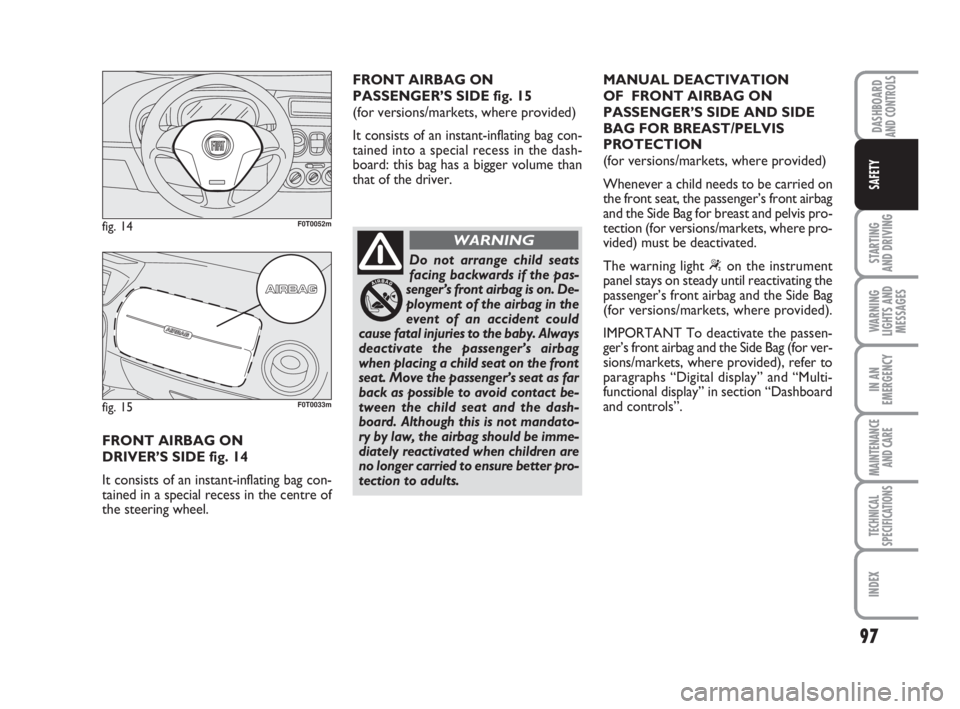
97
STARTING
AND DRIVING
WARNING
LIGHTS AND
MESSAGES
IN AN
EMERGENCY
MAINTENANCE
AND CARE
TECHNICAL
SPECIFICATIONS
INDEX
DASHBOARDAND CONTROLS
SAFETY
FRONT AIRBAG ON
DRIVER’S SIDE fig. 14
It consists of an instant-inflating bag con-
tained in a special recess in the centre of
the steering wheel.
fig. 14F0T0052m
fig. 15F0T0033m
FRONT AIRBAG ON
PASSENGER’S SIDE fig. 15
(for versions/markets, where provided)
It consists of an instant-inflating bag con-
tained into a special recess in the dash-
board: this bag has a bigger volume than
that of the driver.
Do not arrange child seats
facing backwards if the pas-
senger’s front airbag is on. De-
ployment of the airbag in the
event of an accident could
cause fatal injuries to the baby. Always
deactivate the passenger’s airbag
when placing a child seat on the front
seat. Move the passenger’s seat as far
back as possible to avoid contact be-
tween the child seat and the dash-
board. Although this is not mandato-
ry by law, the airbag should be imme-
diately reactivated when children are
no longer carried to ensure better pro-
tection to adults.
WARNING
MANUAL DEACTIVATION
OF FRONT AIRBAG ON
PASSENGER’S SIDE AND SIDE
BAG FOR BREAST/PELVIS
PROTECTION
(for versions/markets, where provided)
Whenever a child needs to be carried on
the front seat, the passenger’s front airbag
and the Side Bag for breast and pelvis pro-
tection (for versions/markets, where pro-
vided) must be deactivated.
The warning light
“on the instrument
panel stays on steady until reactivating the
passenger’s front airbag and the Side Bag
(for versions/markets, where provided).
IMPORTANT To deactivate the passen-
ger’s front airbag and the Side Bag (for ver-
sions/markets, where provided), refer to
paragraphs “Digital display” and “Multi-
functional display” in section “Dashboard
and controls”.
083-100 Fiorino GB 1ed:083-100 Fiorino GB 1ed 30-11-2009 15:53 Pagina 97
Page 104 of 210
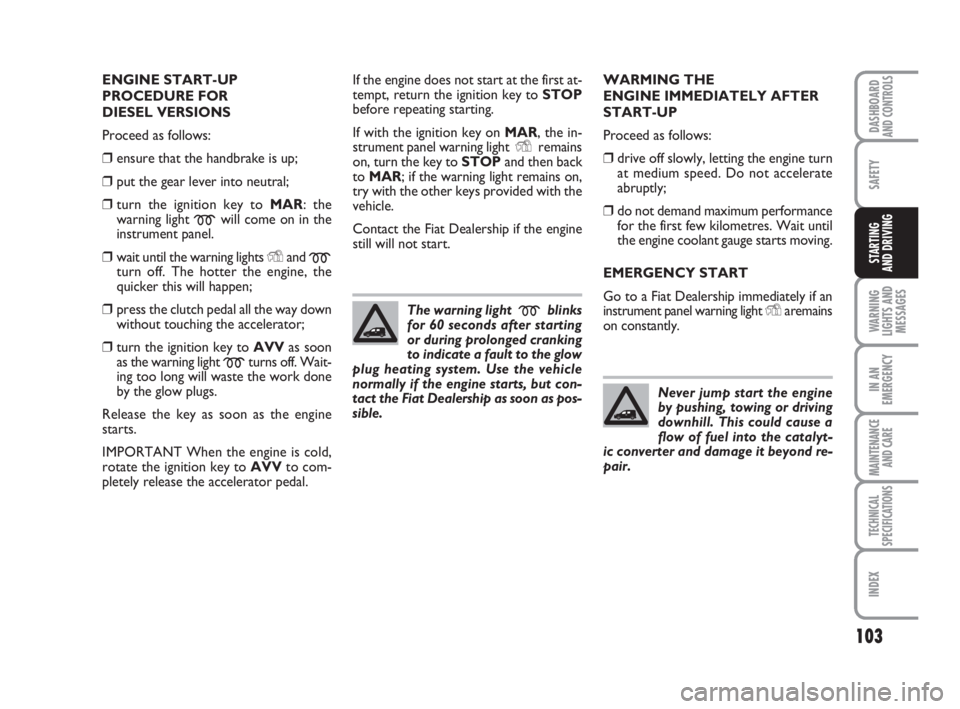
103
SAFETY
WARNING
LIGHTS AND
MESSAGES
IN AN
EMERGENCY
MAINTENANCE
AND CARE
TECHNICAL
SPECIFICATIONS
INDEX
DASHBOARDAND CONTROLS
STARTING
AND DRIVING
ENGINE START-UP
PROCEDURE FOR
DIESEL VERSIONS
Proceed as follows:
❒ensure that the handbrake is up;
❒put the gear lever into neutral;
❒turn the ignition key to MAR: the
warning light
mwill come on in the
instrument panel.
❒wait until the warning lights Yand
mturn off. The hotter the engine, the
quicker this will happen;
❒press the clutch pedal all the way down
without touching the accelerator;
❒turn the ignition key to AVVas soon
as the warning light
mturns off. Wait-
ing too long will waste the work done
by the glow plugs.
Release the key as soon as the engine
starts.
IMPORTANT When the engine is cold,
rotate the ignition key to AVVto com-
pletely release the accelerator pedal.If the engine does not start at the first at-
tempt, return the ignition key to STOP
before repeating starting.
If with the ignition key on MAR, the in-
strument panel warning light Yremains
on, turn the key to STOPand then back
to MAR; if the warning light remains on,
try with the other keys provided with the
vehicle.
Contact the Fiat Dealership if the engine
still will not start.
The warning light
mblinks
for 60 seconds after starting
or during prolonged cranking
to indicate a fault to the glow
plug heating system. Use the vehicle
normally if the engine starts, but con-
tact the Fiat Dealership as soon as pos-
sible.
WARMING THE
ENGINE IMMEDIATELY AFTER
START-UP
Proceed as follows:
❒drive off slowly, letting the engine turn
at medium speed. Do not accelerate
abruptly;
❒do not demand maximum performance
for the first few kilometres. Wait until
the engine coolant gauge starts moving.
EMERGENCY START
Go to a Fiat Dealership immediately if an
instrument panel warning lightYaremains
on constantly.
Never jump start the engine
by pushing, towing or driving
downhill. This could cause a
flow of fuel into the catalyt-
ic converter and damage it beyond re-
pair.
101-110 Fiorino GB 1ed:101-110 Fiorino GB 1ed 30-11-2009 16:14 Pagina 103
Page 113 of 210
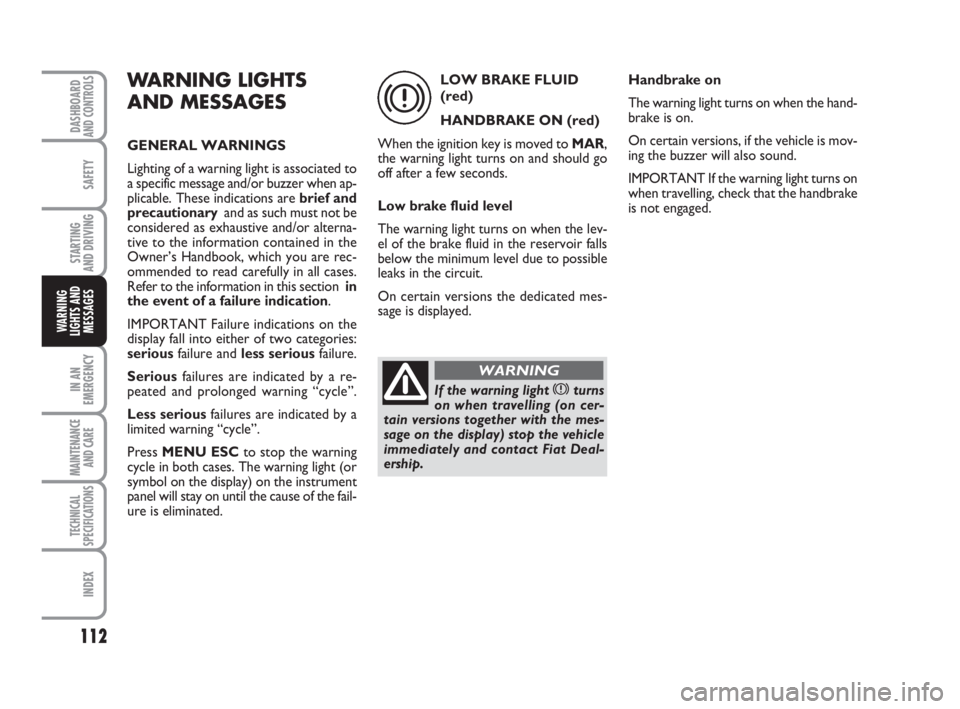
112
SAFETY
IN AN
EMERGENCY
MAINTENANCE
AND CARE
TECHNICAL
SPECIFICATIONS
INDEX
DASHBOARDAND CONTROLS
STARTING
AND DRIVING
WARNING
LIGHTS AND
MESSAGES
WARNING LIGHTS
AND MESSAGES
GENERAL WARNINGS
Lighting of a warning light is associated to
a specific message and/or buzzer when ap-
plicable. These indications are brief and
precautionary and as such must not be
considered as exhaustive and/or alterna-
tive to the information contained in the
Owner’s Handbook, which you are rec-
ommended to read carefully in all cases.
Refer to the information in this section in
the event of a failure indication.
IMPORTANT Failure indications on the
display fall into either of two categories:
seriousfailure and less seriousfailure.
Seriousfailures are indicated by a re-
peated and prolonged warning “cycle”.
Less seriousfailures are indicated by a
limited warning “cycle”.
Press MENU ESCto stop the warning
cycle in both cases. The warning light (or
symbol on the display) on the instrument
panel will stay on until the cause of the fail-
ure is eliminated.LOW BRAKE FLUID
(red)
HANDBRAKE ON (red)
When the ignition key is moved to MAR,
the warning light turns on and should go
off after a few seconds.
Low brake fluid level
The warning light turns on when the lev-
el of the brake fluid in the reservoir falls
below the minimum level due to possible
leaks in the circuit.
On certain versions the dedicated mes-
sage is displayed.Handbrake on
The warning light turns on when the hand-
brake is on.
On certain versions, if the vehicle is mov-
ing the buzzer will also sound.
IMPORTANT If the warning light turns on
when travelling, check that the handbrake
is not engaged.
x
If the warning light xturns
on when travelling (on cer-
tain versions together with the mes-
sage on the display) stop the vehicle
immediately and contact Fiat Deal-
ership.
WARNING
111-122 Fiorino GB 1ed:111-122 Fiorino GB 1ed 2-12-2009 16:18 Pagina 112
Page 125 of 210
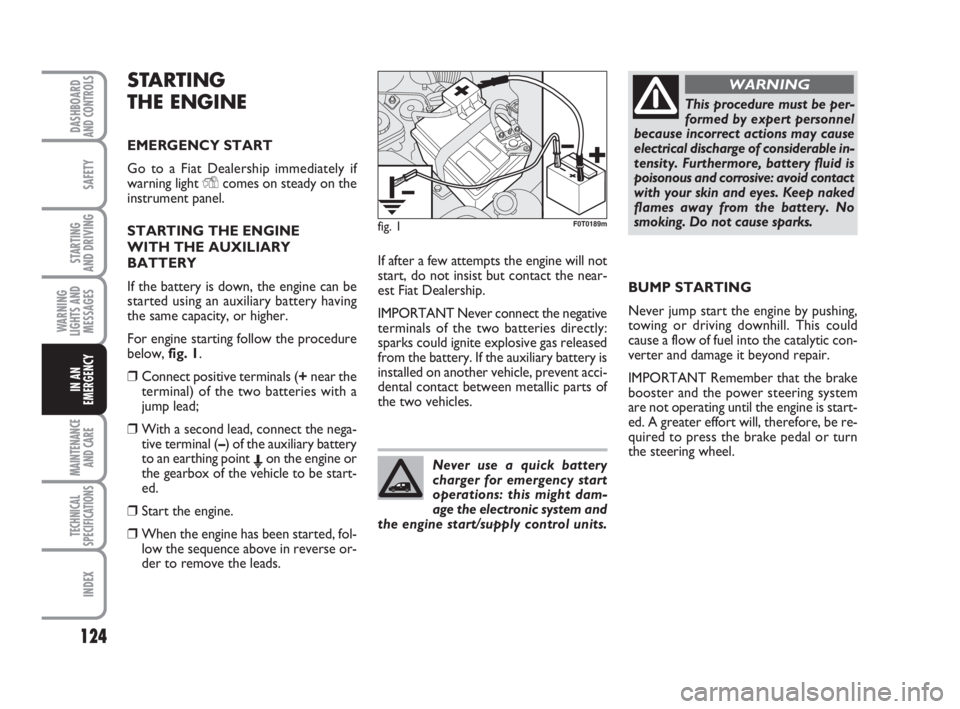
124
SAFETY
MAINTENANCE
AND CARE
TECHNICAL
SPECIFICATIONS
INDEX
DASHBOARDAND CONTROLS
STARTING
AND DRIVING
WARNING
LIGHTS AND
MESSAGES
IN AN
EMERGENCY
STARTING
THE ENGINE
EMERGENCY START
Go to a Fiat Dealership immediately if
warning light Ycomes on steady on the
instrument panel.
STARTING THE ENGINE
WITH THE AUXILIARY
BATTERY
If the battery is down, the engine can be
started using an auxiliary battery having
the same capacity, or higher.
For engine starting follow the procedure
below, fig. 1.
❒Connect positive terminals (+near the
terminal) of the two batteries with a
jump lead;
❒With a second lead, connect the nega-
tive terminal (–) of the auxiliary battery
to an earthing point Eon the engine or
the gearbox of the vehicle to be start-
ed.
❒Start the engine.
❒When the engine has been started, fol-
low the sequence above in reverse or-
der to remove the leads.If after a few attempts the engine will not
start, do not insist but contact the near-
est Fiat Dealership.
IMPORTANT Never connect the negative
terminals of the two batteries directly:
sparks could ignite explosive gas released
from the battery. If the auxiliary battery is
installed on another vehicle, prevent acci-
dental contact between metallic parts of
the two vehicles.BUMP STARTING
Never jump start the engine by pushing,
towing or driving downhill. This could
cause a flow of fuel into the catalytic con-
verter and damage it beyond repair.
IMPORTANT Remember that the brake
booster and the power steering system
are not operating until the engine is start-
ed. A greater effort will, therefore, be re-
quired to press the brake pedal or turn
the steering wheel.
Never use a quick battery
charger for emergency start
operations: this might dam-
age the electronic system and
the engine start/supply control units.
This procedure must be per-
formed by expert personnel
because incorrect actions may cause
electrical discharge of considerable in-
tensity. Furthermore, battery fluid is
poisonous and corrosive: avoid contact
with your skin and eyes. Keep naked
flames away from the battery. No
smoking. Do not cause sparks.
WARNING
fig. 1F0T0189m
123-154 Fiorino GB 1ed:123-154 Fiorino GB 1ed 3-12-2009 15:33 Pagina 124
Page 152 of 210
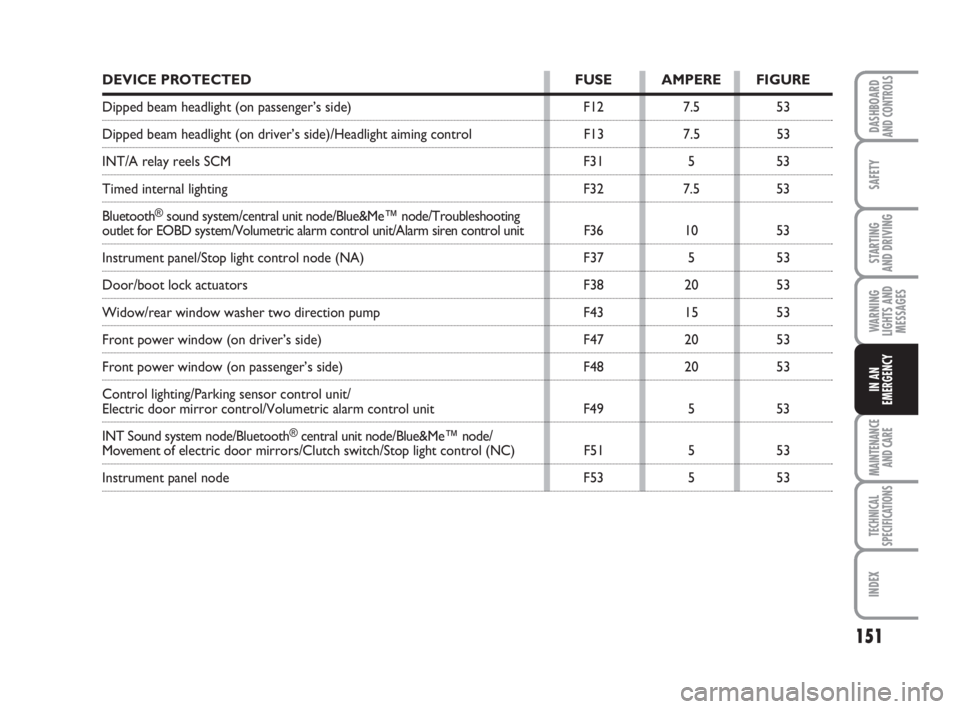
151
SAFETY
MAINTENANCE
AND CARE
TECHNICAL
SPECIFICATIONS
INDEX
DASHBOARDAND CONTROLS
STARTING
AND DRIVING
WARNING
LIGHTS AND
MESSAGES
IN AN
EMERGENCY
DEVICE PROTECTED FUSE AMPERE FIGURE
Dipped beam headlight (on passenger’s side) F12 7.5 53
Dipped beam headlight (on driver’s side)/Headlight aiming control F13 7.5 53
INT/A relay reels SCM F31 5 53
Timed internal lighting F32 7.5 53
Bluetooth
®sound system/central unit node/Blue&Me™ node/Troubleshooting outlet for EOBD system/Volumetric alarm control unit/Alarm siren control unit F36 10 53
Instrument panel/Stop light control node (NA) F37 5 53
Door/boot lock actuators F38 20 53
Widow/rear window washer two direction pump F43 15 53
Front power window (on driver’s side) F47 20 53
Front power window (on passenger’s side) F48 20 53
Control lighting/Parking sensor control unit/
Electric door mirror control/Volumetric alarm control unit F49 5 53
INT Sound system node/Bluetooth
®central unit node/Blue&Me™ node/Movement of electric door mirrors/Clutch switch/Stop light control (NC) F51 5 53
Instrument panel node F53 5 53
123-154 Fiorino GB 1ed:123-154 Fiorino GB 1ed 3-12-2009 15:34 Pagina 151
Page 158 of 210
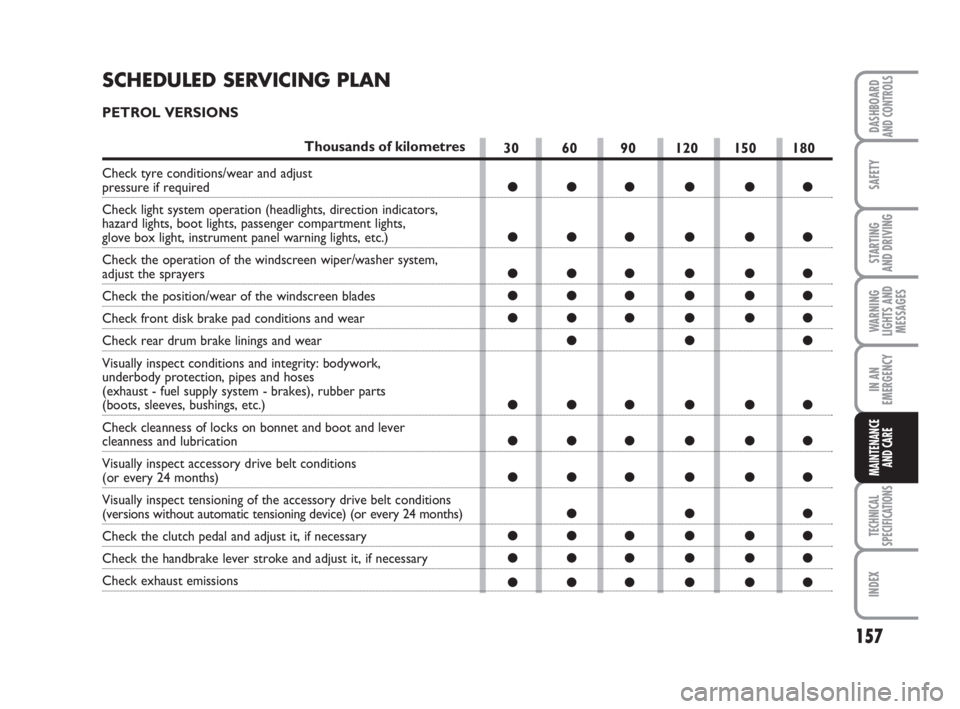
157
SAFETY
TECHNICAL
SPECIFICATIONS
INDEX
DASHBOARDAND CONTROLS
STARTING
AND DRIVING
WARNING
LIGHTS AND
MESSAGES
IN AN
EMERGENCY
MAINTENANCE
AND CARE
30 60 90 120 150 180
●●●●●●
●●●●●●
●●●●●●
●●●●●●
●●●●●●
●●●
●●●●●●
●●●●●●
●●●●●●
●●●
●●●●●●
●●●●●●
●●●●●●
SCHEDULED SERVICING PLAN
PETROL VERSIONS
Thousands of kilometres
Check tyre conditions/wear and adjust pressure if required
Check light system operation (headlights, direction indicators,
hazard lights, boot lights, passenger compartment lights,
glove box light, instrument panel warning lights, etc.)
Check the operation of the windscreen wiper/washer system,
adjust the sprayers
Check the position/wear of the windscreen blades
Check front disk brake pad conditions and wear
Check rear drum brake linings and wear
Visually inspect conditions and integrity: bodywork,
underbody protection, pipes and hoses
(exhaust - fuel supply system - brakes), rubber parts
(boots, sleeves, bushings, etc.)
Check cleanness of locks on bonnet and boot and lever
cleanness and lubrication
Visually inspect accessory drive belt conditions
(or every 24 months)
Visually inspect tensioning of the accessory drive belt conditions
(versions without automatic tensioning device) (or every 24 months)
Check the clutch pedal and adjust it, if necessary
Check the handbrake lever stroke and adjust it, if necessary
Check exhaust emissions
155-176 Fiorino GB 1ed:155-176 Fiorino GB 1ed 30-11-2009 16:34 Pagina 157
Page 160 of 210
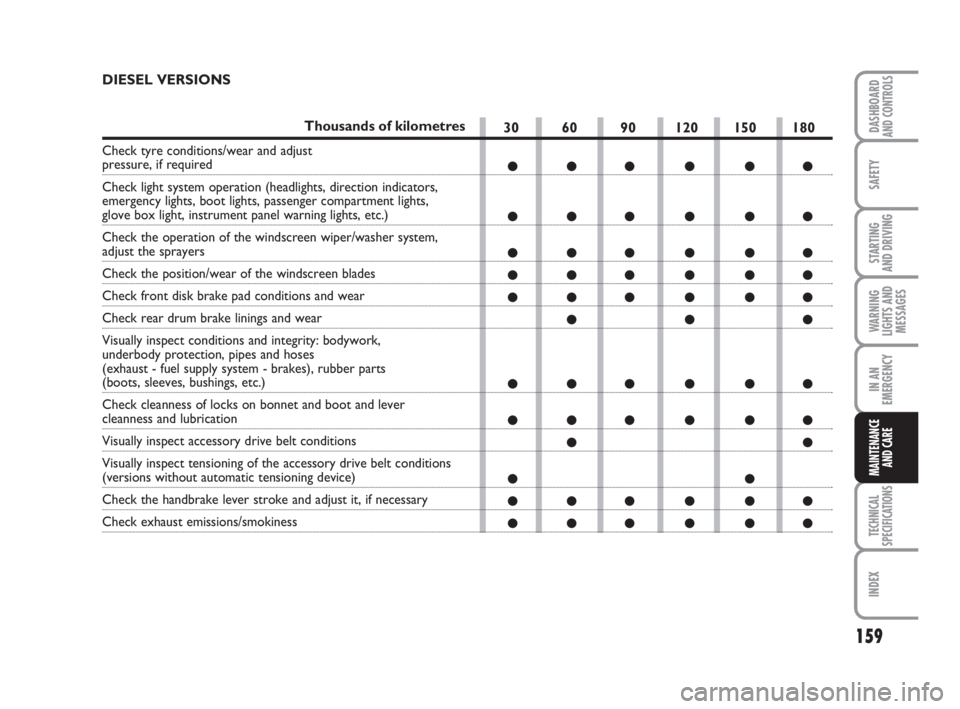
159
SAFETY
TECHNICAL
SPECIFICATIONS
INDEX
DASHBOARDAND CONTROLS
STARTING
AND DRIVING
WARNING
LIGHTS AND
MESSAGES
IN AN
EMERGENCY
MAINTENANCE
AND CARE
30 60 90 120 150 180
●●●●●●
●●●●●●
●●●●●●
●●●●●●
●●●●●●
●●●
●●●●●●
●●●●●●
●●
●●
●●●●●●
●●●●●●
DIESEL VERSIONS
Thousands of kilometres
Check tyre conditions/wear and adjust pressure, if required
Check light system operation (headlights, direction indicators,
emergency lights, boot lights, passenger compartment lights,
glove box light, instrument panel warning lights, etc.)
Check the operation of the windscreen wiper/washer system,
adjust the sprayers
Check the position/wear of the windscreen blades
Check front disk brake pad conditions and wear
Check rear drum brake linings and wear
Visually inspect conditions and integrity: bodywork,
underbody protection, pipes and hoses
(exhaust - fuel supply system - brakes), rubber parts
(boots, sleeves, bushings, etc.)
Check cleanness of locks on bonnet and boot and lever
cleanness and lubrication
Visually inspect accessory drive belt conditions
Visually inspect tensioning of the accessory drive belt conditions
(versions without automatic tensioning device)
Check the handbrake lever stroke and adjust it, if necessary
Check exhaust emissions/smokiness
155-176 Fiorino GB 1ed:155-176 Fiorino GB 1ed 30-11-2009 16:34 Pagina 159